Ebay Message Almost Done We Need a Lirtle More Information in Order to Continue
![]()
![]()
Four Steps to a Successful Sale
![]()
1. Prepare to Sell
Get started with tips and advice on what information to gather about your vehicle and how to take the best photos.
![]()
2. Create Your Listing
From how to describe your vehicle to determining the best price, we'll guide you through creating a listing attractive to buyers.
![]()
3. Manage Your Listing
Once you have your listing posted, learn how to keep track of any activity on it and how to establish contact with potential buyers.
![]()
4. Complete the Sale
Review the final steps you need to take to close the deal: finalize payment, get the vehicle to the buyer, and transfer the title.
![]()
As you prepare to sell on eBay, complete our easy registration process and create a seller's account. Before you begin your eBay Motor's listing, it is important that you use the tools and tips that we provide to help you gather information about your vehicle and take quality pictures. This will increase the chances that your vehicle will sell for the highest amount possible.
![]()
Use the following helpful links as you prepare to sell:
- Register on eBay
- Gather information about your vehicle
- Photograph your vehicle
![]()
![]()
To sell on eBay Motors, you must register to become an eBay member and create a seller's account. This one-time process involves two simple steps: (1) register as an eBay member and (2) create a seller's account. If you've already registered as an eBay member, proceed to the Create a Seller's Account section.
Register as an eBay Member
The one-time registration process at eBay is free and easy. Registering as an eBay member will allow you to bid or buy on eBay. When you register at eBay, you will be asked to:
- Provide your basic contact information. Your information will be kept private on eBay's secure servers.
- Create your own User ID and password to ensure that transactions are safe and secure when you sign in at eBay.
- Confirm your eBay registration via email. eBay will send you a message with a link and instructions to confirm your registration.
Create a Seller's Account
To start selling on eBay, you will need to create a seller's account. This is a one-time process that is free, and your information will be kept private on eBay's secure servers.
When you create a seller's account, you will be asked to:
- Verify your information. To help provide a safe environment for the eBay community, you'll need to provide the following account information:
- Credit or debit card
AND
- Checking account
- Credit or debit card
- Choose how to pay your selling fees. When you create a seller's account, you can choose to have your selling fees deducted from your U.S. checking account or charge them to your credit card.
![]()
![]()
To create an eBay Motors vehicle listing, you will need to gather important information about your vehicle to insure a smooth listing process and a successful transaction.
- Print and complete the Sell Your Vehicle Checklist
Save time by printing and completing our short and easy-to-use checklist to record all of your vehicle information before you go online to create your eBay Motor's listing. This checklist will identify all the information you'll need to sell your vehicle.
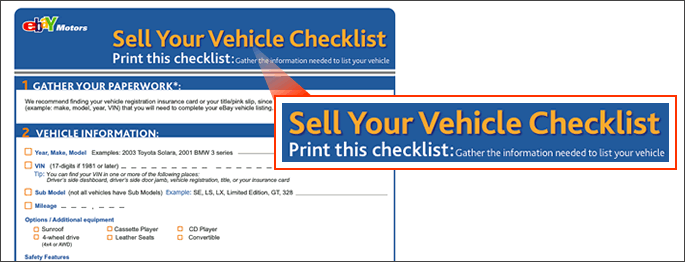
- Be prepared to provide the Vehicle Identification Number (VIN)
If you are listing a vehicle that is newer than 1981 the VIN is required. Even if your vehicle is older than 1981, it is good to include the VIN in your listing.

- Know your vehicle history
If you are not the original owner, it is worthwhile to run a vehicle history report. Make sure that any branded title or history of the vehicle (such as Flood or Salvage) is appropriately disclosed in the description. Even if you've got a current clean title, if there was a salvage title in the history, you must disclose it to buyers. - Locate the vehicle title and have it ready to transfer to the new buyer
- If the title is not in your possession currently, disclose any liens or other limitations on title transfer in the item description, because it could take extra time for you to secure the title and transfer it to the buyer. You may need to contact your lien holder to determine timing and steps of acquiring the title.
- You may want to run a check on your vehicle to make sure the title information kept in public records is accurate. Your insurance company or your state's Department of Motor Vehicles should be able to provide you with this information. You should disclose information about the vehicle title in your listing.
- Check with your Motor Vehicle Department about other requirements.
Some states (such as California) require that the seller complete a smog check, pay taxes, or meet other requirements before selling a vehicle to a new owner. Check with your state Department of Motor Vehicles about your obligations when selling a vehicle.
![]()
![]()
Because most potential buyers will not have the opportunity to see your vehicle in person, it is important that you provide multiple pictures in your listing. People will buy a used vehicle without driving it, but not without seeing it. An online transaction requires the seller to provide a virtual walk around. This is best done with a minimum of 12 photos. We recommend a setting that produces original pictures of 1024x768 pixels (a common size) or some values close to that. Do not use stock photos.
Why are photos important?
- Multiple photos have proven more effective when selling a vehicle.
- Because photos speak for themselves, buyers are likely to have fewer questions during the listing duration.
- Photos provide buyers with added confidence in the seller and ultimately in their bidding and purchase behavior.
Photos should be taken from several vantage points:
- Exterior: all four sides
- Interior
- Engine
- Odometer
- Close-ups of any dings, dents, stains, or other damage
![]()
Photographing Your Vehicle
![]()
Generally, items listed with good photos receive more bids and sell for higher prices than those with poor quality photos. Here are some photos tips for your eBay auction.
Exterior Photos
Provide potential bidders with a full exterior view of your vehicle. At a minimum, you should use ¾ views to capture the front, back, and both sides in two photos; however, the more detail the better. To provide the most effective listing it is important to include a direct front and rear photo along with each side of vehicle to help identify the distinguishing make and model characteristics of the vehicle. These views are useful, because they can also show options like fog lights (front) or trailer hitch (rear).

Condition or Damage Photos
As you walk around the outside of the vehicle, check to see whether there are any other details that show the condition. In order to increase buyer confidence, you should take photos of any notable issues including:
- Dents, rust, interior damage, rips, tears, paint fade, and scratches
- Cleanliness of wheels and tire tread
- Grill and font end of car
- Truck bed (if applicable)
Buyers should be aware of any known problems before they complete the purchase. Many successful sellers use blue masking tape to highlight damage, because damage is sometimes difficult to see in a digital picture.

Interior Photos
Photograph all the details a buyer will want to see inside the vehicle. Make sure to photograph the seats, dashboard, and any optional equipment (such as a stereo), floor carpets, backseat, or other interior angles. Also include any items that help identify optional equipment, such as trim level and condition.
Lighting is important for interior photos as shadows and poor lighting can make them difficult to see online. Use of a flash for interior photos.

Odometer and VIN Photos
Take close-up photos of the odometer reading and the VIN. Take a picture of the odometer reading with the keys in the ignition and the power turned on so the mileage appears clearly in the photo.
Lighting is important for interior photos as shadows and poor lighting can make them difficult to see online. Use of a flash for interior photos.

Engine Photos
Buyers will want to know that the engine has been maintained and is in working condition. This is especially true of older and collector vehicles. One photo of the entire engine compartment with good lighting is usually adequate.

![]()
Tips on Taking Photos
![]()
Framing
The car should fill the frame of the photograph.
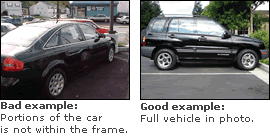
Composition
Background should be neutral, so that it is easy to see the vehicle.
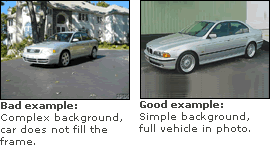
Lighting
Shadows and poor lighting can make photos difficult to see online. Shadows from trees and buildings can obscure a clear view. Early morning or late afternoon light is generally best for photos. You should have your back to the sun and watch for shadows, including your own. Use a flash for interior and engine shots.

![]()
Your next step is to create an eBay Motor's listing that will entice buyers to purchase your vehicle. Be sure to include a detailed description of your vehicle, the terms of sale, and a realistic price based on research that supports your vehicle's value.
Use the following helpful links to create your listing:
- Describe your vehicle
- Price your vehicle
- Set terms of sale
![]()
![]()
You are now ready to create your eBay Motor's listing. Use the Sell Your Item form to get started.
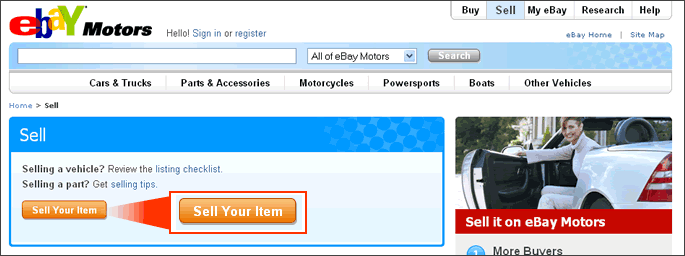
If you did not already complete the Sell Your Vehicle Checklist, you should do so now before you continue to create your eBay Motor's listing. The information on this checklist will help you create your listing.
You will be asked to provide a Vehicle Identification Number (VIN) when you complete the Sell Your Item form. Entering a VIN allows eBay to pre-populate your listing with information that is specific to your vehicle. This results in a more robust listing.
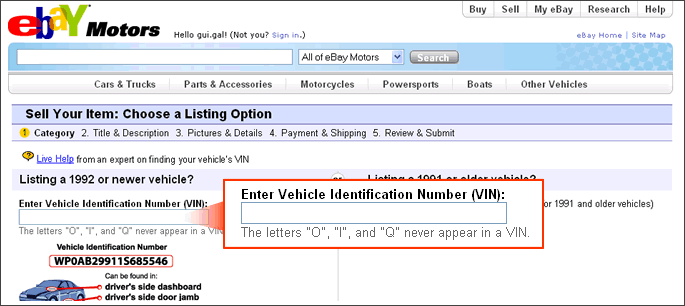
It is important to be completely honest in your description as this builds buyer trust and may help you sell at a higher price. Be professional, thorough, and clear.
A good description includes:
- Make, model, sub model, and year
Example: "You are bidding on a 2002 BMW 328is." - Engine type and transmission
Example: "2.8 liter 6-cylinder with manual transmission" - Vehicle condition for the interior, exterior, and engine
Examples:- "The paint has faded on the hood and roof."
- "This is a non-smoker vehicle."
- "My mechanic recommends replacing the shocks and struts."
- Options and option packages
Example: "Sport package including sunroof, leather seats, sport wheels, and traction control." - Interior and comfort features
Example: "Leather seats with power adjustments" - Any notable additions or modifications to the vehicle
Example: "I added 18" custom wheels in 1998 including a new set of snow tires. I also disabled the alarm." - Ownership history
Example: "I am the original owner and bought the car from Seaside BMW in 1997." - Maintenance records, if any
Example: "I have all records of service from my ownership and the previous owner." - Recent service
Example: "The car has new tires and a new clutch installed less than 2 months ago." - Warranty coverage
Example: "The car is still protected by a powertrain warranty that has one year left of coverage."
![]()
![]()
Your next step is to determine a realistic price for your vehicle.
![]()
Research Your Vehicle's Value
![]()
A great way to determine a realistic price is to search for the make/model you are interested in on eBay Motors. You can then use the Price Research tab to find detailed pricing information based on past eBay sales, current eBay listing prices, and industry leading price research data.
![]()
Determine a Pricing Strategy
![]()
The most successful sellers on eBay Motors choose the best auction and pricing strategy to meet their objectives. Selecting the right strategy will lead to more bids and the successful sale of your vehicle. In general, set the starting price low to attract buyers' attention and drive market excitement. There are basically four pricing strategies to consider: Reserve Price auctions, No Reserve Price auctions, Buy It Now listings, and Best Offer listings.
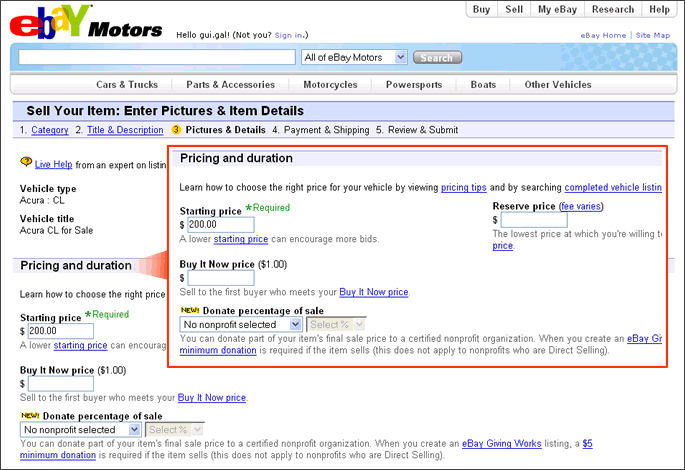
Reserve Price Listing
A Reserve Price Auction enables you to set a reserve price, which is the minimum price that you are willing to accept. This minimizes risk, because there is no obligation to sell until the reserve price is met.
When should you use a reserve auction?
- Effective for late models and higher priced vehicles.
- Popular with sellers with little or no experience selling their vehicle on eBay Motors.
Tips:
- Set your reserve price as the lowest possible price that you are willing to accept.
- Set your reserve price close to trade-in, as most sales on eBay Motors are between trade-in and retail. New sellers often make the mistake of pricing too close to retail; as a result, bidding excitement never gets a chance to start and their items don't sell.
- Set a low starting price to create bidding momentum as early as possible. Listings with high starting prices and an unknown reserve fare poorly on eBay Motors.
Note: If you've chosen to use a Reserve Price Auction format, you may lower your reserve or remove your reserve price during the auction to sell your vehicle quickly.
No Reserve Price Listing
In No Reserve Price Auctions, any bid at or above your starting price wins the auction.
When should you use a No Reserve Price Auction?
- Effective for older and lower priced vehicles.
- Effective if you are looking to sell your vehicle in a hurry and getting the right price is less critical.
- Popular with vehicle sellers who are more experienced in the eBay marketplace.
Trends to Consider:
- A No Reserve Price Auction with a high starting price that is equivalent to a reserve price will receive very few bids until the final hours of the auction. Bidding rates are generally higher for these types of auctions than Reserve Price Auctions, but a high percentage of these auctions end with no bids.
- A No Reserve Price Auction with a low starting price is for the seller who is comfortable turning a profit based on volume. This method is potentially risky, because the seller could take a loss if multiple bidders do not drive up the price. This approach, however, does drive bidding activity and almost guarantees that the vehicle will sell.
Buy It Now Listing
The Buy It Now price allows you to specify a fixed sale price for your vehicle.
When should you use the Buy It Now price?
- To price your vehicle for a fast sale.
- In a reserve or no reserve auction listing to give your buyers the option of purchasing the vehicle immediately at a fixed price.
- To show buyers that you are serious about making a deal.
- Many buyers judge the value of the reserve price according to the Buy It Now price. If your reserve price is lower than the Buy It Now price, consider mentioning that in your listing.
Tips:
- Setting an unrealistically high Buy It Now price-like a "sticker price"-can scare away potential buyers.
- You can lower your Buy It Now price during the auction to show buyers that you are willing to sell the vehicle immediately for a fixed price provided there is a minimum of 12 hours left before your listing ends. You may also add a Buy It Now price to allow a buyer to end the auction immediately and win the vehicle-provided there isn't a winning bid. Learn more about how to revise your price.
Best Offer Listing
With Best Offer with buyers can offer a price they are willing to pay for your vehicle. Once your accept an offer, the listing is closed and the buyer is obligated to pay the price offered. If you agree to review Best Offers, a Make Offer button displays on your listing page in the same area as the Buy It Now or Advertised Price.
When should you use a No Reserve Price Auction?
- Effective for older and lower priced vehicles.
- Effective if you are looking to sell your vehicle in a hurry and getting the right price is less critical.
![]()
![]()
Your listing will be your primary means of communication with potential buyers. Therefore, it is important for the buyer and the seller to understand and agree to the terms of sale.
As you create your listing, you should specify the following information:
Payment Terms
Describe your requirements for payment in detail. Let the buyer know if you require a deposit, what payment methods you accept, and when the balance payoff (or full amount if you do not require a deposit) is due.
Deposit
It is a common practice for eBay Motors sellers to require a deposit within 72 hours after the end of a successful listing. Specify the amount of the deposit and a reasonable period of time in which you expect to receive it. Consider using PayPal to accept deposits via credit card and bank account deposits online, because this is a standard form of payment used by eBay buyers.

Balance Payoff Amount
Specify how and when you'd like the balance to be paid. Most sellers require a certified check, money order, or some type of financing.
![]()
Financing Through eBay
![]()
Let buyers know that they can apply for financing at the eBay Motors Financing Center or on the Financing tab before they place a bid or offer to buy your vehicle. Deals may close faster with loans arranged through the Financing Center. Consider providing a link to the Financing Center in your listing.
![]()
Shipping or Pickup
![]()
It is standard practice on eBay Motors for the buyer to make the arrangements and pay the costs associated with picking up or shipping the vehicle. Specify who will pay for the shipping and whether you will be willing to deliver the vehicle within a specific driving distance. Many eBay Motors buyers will drive or fly to the seller's location to pick up the vehicle. As a seller, you can facilitate the fulfillment of the sale by making it easy for buyers to understand their options.
Sellers will often provide estimates of shipping costs to various locations around the U.S. eBay Motors also provides buyers with an option to arrange shipping in the Shipping Center and on the Shipping tab associated with any vehicle. Always include your city and ZIP code in your listing. Buyers can use this information to get a free online quote for vehicle shipping.
![]()
Vehicle Inspection
![]()
Specify whether you have already performed an inspection or you would allow your buyers to have the vehicle inspected at their own time and expense prior to the close of sale.
eBay Motors recommends arranging inspections through SGS Automotive. With their 150-point vehicle inspection, SGS Automotive helps you build the confidence that is crucial to any vehicle or motorcycle sale. Learn more about SGS Vehicle Inspections.
![]()
You can manage your listing through My eBay. Once signed in to My eBay, you can add information or upgrade your listing to attract more buyers. You can do this at any time while your listing is active. You can also establish contact with your potential buyers to increase the chances that your vehicle will sell.
Use the following helpful links to you manage your listing:
- Actively participate in the process
- Revise pricing (if applicable)
![]()
![]()
Once your listing is active, you should build a relationship with potential buyers by email or phone. This will strongly increase your chances of arriving at a successful sale.
![]()
Be Accessible to Potential Buyers
![]()
Make sure that your phone number and email address on your eBay account is accurate. The serious buyer will be more likely to engage in business with you if you are open and responsive to questions and concerns in a timely manner - both during the listing period and after the purchase when transactional details are being resolved. You may want to consider adding your telephone number to your item description in order to further facilitate communication. This can also add to the buyer's sense of trust in a seller. eBay buyers expect customer service from the sellers, and that's what drives the feedback score. "Great communication!" is a common feedback comment. Be sure to schedule time every day to check your listings and look for emails containing questions about the vehicle.
![]()
Reach Out to Potential Buyers
![]()
If you have questions about a potential buyer's feedback rating or bidding activity, you should contact the buyer directly. It's likely that the potential buyer has questions regarding the vehicle or the terms of sale and will appreciate that you initiated communication. The best sellers talk to every serious buyer. This results in a higher level of buyer trust, more bids, and an increase in final sales, because communication problems are avoided that might have resulted in an unpaid item.
![]()
Manage Listings Using My eBay
![]()
One of the best ways to track your listings is by using My eBay - a central place where you can manage all your eBay activities. You can click "My eBay" at the top of almost any page on eBay Motors. Next, select the Selling tab to track the current price of your listings and the number of bids that you have received. You can use My eBay to lower your reserve or Buy It Now price.
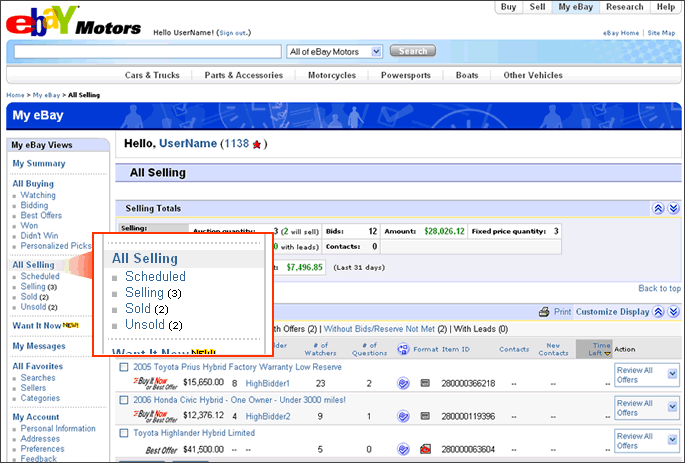
When you have received bids, you can contact bidders by accessing your listing, and then viewing the bid history.
![]()
Use the Bid History Page
![]()
The Bid History page is your source for contacting bidders. You can access the Bid History page by clicking the link in the History section on your vehicle listing.
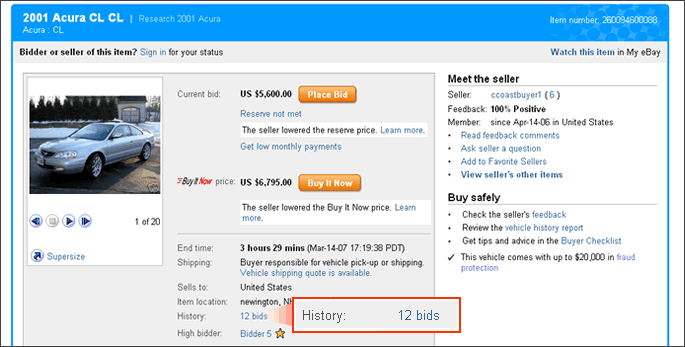
![]()
Request Member's Contact Info
![]()
You can also request more contact information about the bidders by using the Find Contact Information search option.
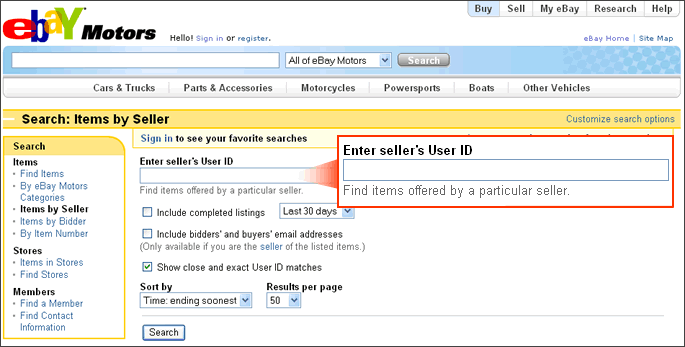
This member information is provided by eBay with the intention of better facilitating a specific transaction between members and must be used in accordance with eBay's Privacy Policy. This tool is not intended for the harvesting of information or for any other purpose, such as facilitating future transactions, or disseminating unsolicited email campaigns. Misuse of the tool is considered a serious infraction and may result in permanent suspension from the eBay Web site.
![]()
![]()
If your listing isn't receiving the bidding or buying activity that you expected, consider revising your price. The pricing information that you can revise depends upon the remaining time before your listing ends and whether users have bid on or purchased your items. Learn more about how to revise your price.
If you want to change, add information, or upgrade your listing to attract more buyers, use the Revise Your Item page. Learn more about the types of changes that you can make.
![]()
Once you've sold your vehicle, you'll need to collect payment and confirm the pickup or shipping arrangements with the buyer. Be sure to check with your state's Department of Motor Vehicles for details on how the title transfer should be handled.
Use the following helpful links to close the deal:
- Finalize Payment, Shipping, and Title Transfer
- Utilize Second Chance Offer or Relist your vehicle (if applicable)
![]()
![]()
Receive Payment
![]()
You should have already established your payment terms in your eBay Motors listing. Sellers are encouraged to accept deposits via PayPal and the balance of the payment via the Financing Center. However, sellers are welcome to accept or deny any type of payment, as long as those terms are clearly explained in the listing.
![]()
Complete the Sale: Arrange Pickup / Shipping
![]()
You should have already established your pickup and/or shipping terms in your eBay Motors listing. Most buyers opt to pick up the vehicle in person; however, if shipping services are required for your transaction, please make sure the shipping company that you and the buyer agree to use is fully bonded and insured.
eBay Motors recommends a number of dependable shipping companies that are listed in the Shipping Center. But if you have a prior relationship with a trustworthy shipping company, you might want to offer to help arrange for shipping.
![]()
Complete the Sale: Transfer Title
![]()
You will need to transfer the title of the vehicle to the new owner. Each state has slightly different rules on how the title transfer should be completed. We recommend that you visit your state's Department of Motor Vehicles to review detailed information about transferring titles to the new owner.
![]()
![]()
If for some reason your vehicle did not sell, you can make a Second Chance Offer to one or more of your bidders or take advantage of the free Relist policy on eBay.
![]()
Utilize a Second Chance Offer
![]()
Even if the auction closes unsuccessfully, you can make a Second Chance Offer to one or more of your bidders. A Second Chance Offer allows you to contact the bidders on your ended listing with a lower offered price on the vehicle. You and the buyer can agree on any price that you want, but your automated offer must be lower than your previous reserve price.
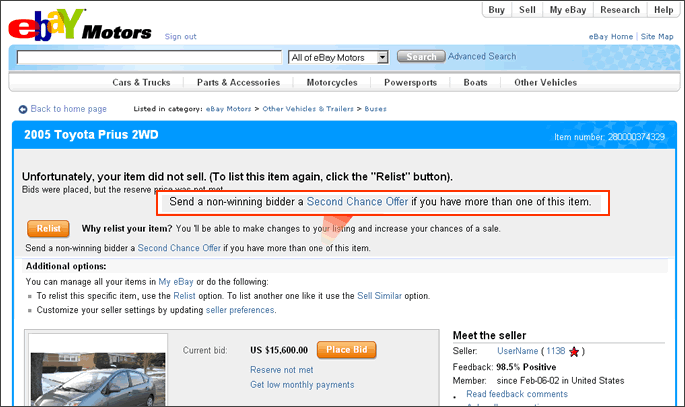
Sellers can send a Second Chance Offer from any of these pages:
- Bid History page: Go to your closed listing and then click the "Bid History" link.
- My eBay page: In the Items I've Sold section, click the Action menu and select "Send a Second Chance Offer."
- Item page for a closed listing: Sign in with your User ID and then click the link for the Second Chance Listing tool.
Note: The "Second Chance Offer" link is only available for closed listings with at least one non-winning bidder.
![]()
Relist Your Vehicle
![]()
You can always relist your vehicle by clicking the Relist Item button on the bottom-left corner of your item page. You will be credited the Insertion Fee if your vehicle sells.
Normally, Insertion Fees are non-refundable. However, if your listing ends without a winning buyer or results in an unpaid item (UPI), you may qualify for a credit by relisting the item. If the item sells the second time, eBay will refund the Insertion Fee for the relisting. Learn more about relisting your vehicle.
Source: https://pages.motors.ebay.com/sell/howto/print.html
0 Response to "Ebay Message Almost Done We Need a Lirtle More Information in Order to Continue"
Post a Comment